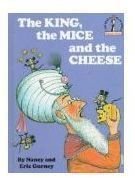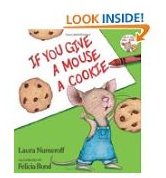If You Give a Mouse a Cookie Extension Activities
After the Story
After reading If You Give a Mouse a Cookie to your students, you will all be ready for some extension activities.
Begin by teaching the song “There’s a Hole in My Bucket Dear Liza, Dear Liza” and asking the children how it is similar to the story (it is a circular story). Ask them what other things are cyclical? (seasons, months of the year, etc.). Invite students to make up their own “circle” story. Examples of circle templates are a season wheel template which you can supplement with the season wheel cut-out template.
Have students form a circle. The teacher starts off the game by saying “If you give a boy a crayon…….”, or “If you give an elephant a peanut…..” etc. Ask the children to take it in turn to add to the story. Be ready to improvise if any student flounders with a response; this should be a fun game.
Real Mice
After discussing that the mouse in the story is fictitious, suggest to the students that they are now going to explore real mice. Make a chart with columns showing: 1) What we know about mice; 2) What we want to know.
Concepts:
Mice are born alive.
Mother takes care of the young.
Mice can be good pets.
Mice can be pests.
Mice eat a variety of food.
Mice have enemies.
Students will research through books, the Internet, and pictures as well as asking people who have pet mice.
As a group, fill in the chart with information. On another chart ,display words that describe the things that mice do: squeak, nibble, scratch, scurry, skitter, gnaw. Choose four of these words and write a sentence for each one.
Provide booklets in the shape of a mouse for the students to write stories, telling what they know about mice. Encourage the students to use the charts to help with spelling.
Ask students if they have heard the expression “As quiet as a mouse”? What do they think it means? Can they think of any more similes? - as sly as a fox, as wise as an owl.
Use pictures of mice and their tails for math activities - measuring tails, ordering the mice by size, and so on.
What Do Mice Love to Eat?
Mice love to eat cheese. Read the story of The King, the Mice and the Cheese by Nancy and Eric Gurney or The Cheese by Margie

Palatini. Provide a taste of cheddar cheese to each of the students, and ask them to use a word to describe it - there are many descriptive words about cheese in the book The Cheese.
Provide cheese-shaped paper, and ask students to write a story about a mouse, who maybe hated cheese, or about a mouse that caught a cat who was stealing his cheese.
Make a list of “ch” words. Choose three words from the list and try to put all of them in one sentence.
Culminating Activities.
If You Give a Mouse a Cookie extension activities can be wrapped up with a wonderful Mouse Party.
Invite students to make headbands. Then draw a picture of their favorite mouse and attach it to the front of the headband.
Introduce your students to cookie making. Use frozen cookie dough, and cut it into slices. You can bake them in an electric frying pan if there are no cooking facilities available.
Serve crackers and cheese.
Sing Mouse Songs - Three Blind Mice, Hickory Dickory Dock.
Read Mouse Stories:
Mouse Paint by Ellen Stoll Walsh
Alexander and the Wind-Up Mouse by Leo Lionni
The Litte Mouse, The Red Ripe Strawberry, and The Big Hungry Bear by Don and Audrey Wood
Make “Mousekins”. Provide stamp pads of different colors. Students press their thumbs on to the stamp pad and make a thumb print on white paper. Add ears, whiskers, feet and a tail with fine tip markers. Make book marks out of the Mousekins papers.
Play a game of “Pin the Tail on the Mouse”
Have fun!
This post is part of the series: “If You Give a ………..” - Books by Laura Numeroff and Felicia Bond
This series of books is a great starting point for vocabulary activities, beginning sounds, exploring math concepts and looking at the chain reaction story format. Children love the silly nonsense portrayed in each book.
